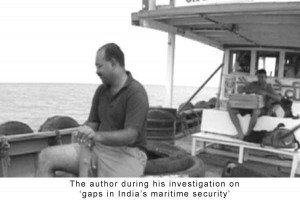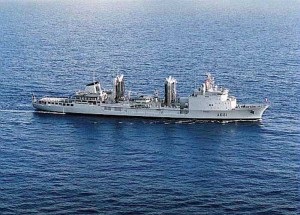Way back on August 1, 2007 the London based International Maritime Bureau (IMB) had opened a 24 hour communication hot line where callers could anonymously relay information on sea piracy, crime and terrorism. So strategic thinking on maritime terrorists pro-actively linking up with sea pirates opened up a year and half ago. IMB, a global maritime watchdog agency, set up the piracy center in Kuala Lumpur.
The IMB has warned that piracy could be on the rise and, therefore, the threat of maritime terrorism in the Indian Ocean cannot be taken lightly.
“It is a good concept. Shipyard workers or ship crew may know something but most are reluctant to report to the police or to the ship owner because they are afraid of being detained or of losing their job,” said the centre’s chief, Noel Choong, during its inauguration. “Now we are giving them an option to report to us. It will be a big boost to fighting crime and terrorism at sea,” he said. The IMB will assess the reliability of the information before passing it to law enforcement agencies in the countries concerned, who will have to verify if the threat is real, he said. Seafarers, port workers, shipping agents, shipyards, brokers and stevedores across the world can now call this hot line telephone number +603-20310014 or fax the critical information to +603-20785769 or email it to imbsecurity@icc-ccs.org.
The IMB has warned that piracy could be on the rise and, therefore, the threat of maritime terrorism in the Indian Ocean cannot be taken lightly. In fact, maritime terrorism in the Malacca Strait which carries half the world’s oil trade and a third of global commerce is now seen as a realistic scenario. Some 200 ships use the straits every day to travel from Europe and the Middle East to Asia. Pirate attacks in the waterway have declined in the past three years after Malaysia, Indonesia and Singapore introduced coordinated security patrols, but concerns still linger that militants could hijack a ship carrying hazardous material and use it as a floating bomb.
Security of Ports
India is inadequately prepared to tackle maritime terrorism. On December 20, 2008, weeks after the Mumbai 26/11 attack, the Union Home Secretary, Madhukar Gupta chaired a high-level meeting in New Delhi last Thursday to discuss various issues relating to the security of ports. In 2009 India will take the first steps in establishing a security architecture that aims to secure the water area related to ports and the ports from maritime terror attacks.
 A mechanism to coordinate the functioning of the state police, Customs and Coast Guard-the agencies that patrol in the water area related to ports-will also be set up. Several decisions taken at that meeting will be implemented this year like providing two interceptor boats to every port and detailed examination of the irregular and unregulated movement of boats including fishing boats.
A mechanism to coordinate the functioning of the state police, Customs and Coast Guard-the agencies that patrol in the water area related to ports-will also be set up. Several decisions taken at that meeting will be implemented this year like providing two interceptor boats to every port and detailed examination of the irregular and unregulated movement of boats including fishing boats.
Central Industrial Security Force, personnel will also be deployed inside the ports. A standard operating protocol/procedure for initiation and deployment of anti-terror commando units in the eventuality of a terror attack and their interaction with other security agencies is also being generated. But, as is self evident, a lot more needs to be done, including a comprehensive security audit of the most vulnerable ports to begin with and in a phased manner all ports, fishing harbours, jetties and landing points, must be necessarily carried out by a joint task force which has expert representatives from various agencies.
Also several ports in India categorized as minor ports fall under the State Government’s control and these ports could be more vulnerable to maritime terrorism. In the meantime basic security drill like access control, surveillance systems, I-cards for employees and so on should be immediately implemented in all ports in India.
Security – Resource Mismatch
The daring piracy operations of non-state actors in the Gulf of Aden and the Mumbai 26/11 terror attack have made these scenarios come alive within the realm of possibility.
“¦several ports in India categorized as minor ports fall under the State Governments control and these ports could be more vulnerable to maritime terrorism.
These scenarios are potential illustrations of terror’s new watery frontier. With the bombing of USS Cole off Yemen in 2000 and a similar attack on the French oil tanker Limburg two years later, the sea is indeed the new playground of Al Qaeda’s 21st Century terrorism. Is India prepared to combat and counter maritime terror?
The mismatch between the security challenge and the resources available to tackle it is daunting. The Indian Coast Guard has a fleet of 76 vessels, 24 fixed wing aircraft and 18 helicopters to police a 7,600km coastline and a 2.02 million square km Exclusive Economic Zone (EEZ). In addition to this inadequacy, most of the 140 ships of the Indian Navy cannot operate in shallow waters where terrorists operate, a security nightmare best illustrated along the east coast especially along Tamil Nadu where there are nearly 400 landing points along a roughly 1000-km coastline.
The LTTE Factor
Intelligence agencies have inputs which indicate that terror groups are getting more ambitious with their maritime agenda. With the Liberation Tigers of Tamil Eelam (LTTE) in complete disarray as a result of Sri Lankan Army’s sustained onslaught and the recapture of LTTE’s administrative headquarters, Kilinochi, the Tamil Nadu coast has now become ultra-sensitive.
The Coast Guard says that it will need much greater force and a larger fleet to keep Indian waters safe
Last year there were several seizures along the Tamil Nadu coast of contraband consignments meant for the LTTE. Four LTTE cadres and an Indian supporter along with ammunition including a suicide body belt and AK 56 rifles were recovered from a Sea Tigers’ boat which was apprehended by the Coast Guard while it was sailing in Indian waters.
The boat lined with explosives was destroyed by the police. Commenting on this development, security and strategic expert and former Additional Secretary R&AW, B Raman, had stated that the “LTTE has been reviving it’s arms movement from India which they had discontinued after Rajiv Gandhi’s assassination.” Now with the war in northern Sri Lanka decisively tilted in favour of the Sri Lankan Army, and with the LTTE finding it extremely difficult to hold on to its Sea Tigers base in Mullaitivu, analysts believe that the Tamil Nadu coast might once again be used as a supply base.
 Last year the Navy, Coast Guard and Tamil Nadu Police seized more than five different consignments of explosives on their way to LTTE controlled destinations in North and Northeastern Sri Lanka. Amongst the seizures were:
Last year the Navy, Coast Guard and Tamil Nadu Police seized more than five different consignments of explosives on their way to LTTE controlled destinations in North and Northeastern Sri Lanka. Amongst the seizures were:
- Over 6 tonnes of Alumunium based metals, used for making IEDs.
- The Tamil Nadu Police arrested three Indians and seized two tonnes of Aluminium powder from a Madurai factory.
- Four Sri Lankan Tamils and three Indians were arrested with of ball bearings that are used as shrapnel in bombs.
- Live rockets were recovered from the sea bed near Rameswaram.
These seizures last year were humble reminders of the fact that despite a strong counter intelligence network in Tamil Nadu, intelligence agencies perhaps were caught napping because the LTTE had managed to set up new supply routes and pick-up points on Indian soil. The then Director General of Police, D Mukherjee, admitted that “there are constraints of manpower. We do our best. Whatever intelligence we get we act on it. But certain things still go on.” With the 56 and 57 Divisions of the Sri Lankan Army now battling to recapture the stretch between Kilinochi and Mulaitivu on the eastern coast of Sri Lanka, there is a threat perception of the LTTE sending its cadres as refugees to India.
The 2008 seizures in which Indians were also arrested point to an even more serious twist. At that time SC Chandrahasan of the Organisation for Eelam Refugee Rehabilitation had pointed out that the “LTTE has been successful in hiring local Indians and that could make the conflict more serious.”





The issue with terrorism is, that it is increasingly pan-nation, and carried out by parties that are also seen as suspect by their own nations, religious affiliation etc.. It might be, that Pakistan says that the Lashkar is a legitimate party, to other nations, because they want the Lashkar and it’s views to be relevant to India, and perhaps within Pakistani Punjab also, because they seem to be wanting a relevant outlook. In Pakistan, there were many bomb blasts reported in the Punjab, and if the Lashkar is a registered organization, and seen to be not an affiliation to govt., but registered as some organization, perhaps a charitable organization, then the govt. will have no reason to suspect the organization, and nor will the organization see any relevant reason to the situation.
The U. S. saw a similar situation in Pakistan. In a relevant scenario, every bomb blast in India has a certain reason, but in Pakistan, no bomb blast, in the time when there were about 4 blasts happening every week, was seen to be reported as Indian govt. caused. The Indian press was reporting that the U. S. was aiding Gen. Musharraf, with infusions of Dollar funds, then, and the truth is that it was seen that the Pakistani Gen. was doing the best he could, from preventing Pakistan from collapsing. It seems, that internal security is the need of the minute, then.